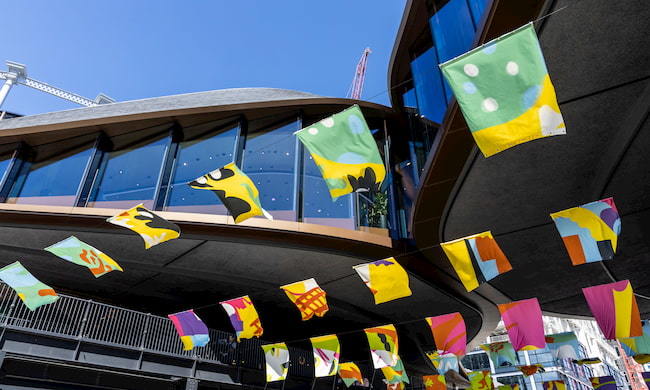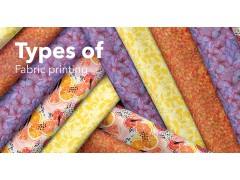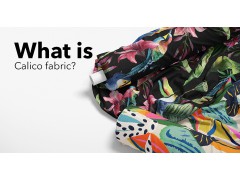So, what are the different types of fabric? Let’s dive in!
1. Cotton
Any types of fabric list usually starts with one of the all-time classics: cotton. Cotton fabric is an old-school type of fabric. A natural product, cotton is very versatile, and suitable for a lot of different types of projects, including clothing, pillows, curtains, towels, and bedding.
Pros:
- Soft
- Feels nice to the touch
- Sturdy
- Moisture-absorbing
- Breathable
- Easy to dye
Cons:
- Creases easily

Creation by Atelier Meesters (Katoen Popeline Eco)
2. Twill
Aside from the types of fabric materials used, the weave of a fabric can also determine its properties. Twill fabric is a type of cotton fabric with a very thick weave. This durable fabric is versatile, used in both clothing and interior design, ranging from pillows to shoe linings.
Pros:
- Strong
- Easy maintenance
- Breathable
- Comfortable
- Ranging from light- to heavyweight
3. Voile
Voile is an airy cotton (blend) fabric, used in the fashion industry for things like blouses and scarves, but it can also be used to make curtains. Its distinctive feature is its sheerness, which sets it apart from most fabrics.
Pros:
- Sheer
- Lightweight
- Crisp
- Soft
Cons:
- Stiff
4. Linen
Linen is the quintessential summer fabric. It’s airy and often used for blouses, bedding, wide-leg pants, skirts, and dresses. Its casual look also makes it perfect for interior design, where it’s used to upholster things like pillows or poufs.
Pros:
- Airy
- Well-ventilated and -insulated
- Dries quickly
Cons:
- Creases easily
5. Silk
Out of all fabric material types, silk is one of the most high-end ones. Because it’s a smooth, breathable, and lightweight fabric, silk tends to be used for making quilts and pillows, but also blouses, tunics or tops.
Pros:
- Drapes smoothly
- Beautiful sheen
- Lightweight
- Anti-static
- Temperature-regulating
- Good to sleep on (or in) if your skin is sensitive
Cons:
- Not elastic
- Fairly expensive
- Silk must be washed carefully

Creation by Wilma Lieben (Zijde Satin 12,5 m/m)
6. Cotton silk
Cotton-silk is a hybrid of cotton and silk: the best of both worlds! It inherits the shiny feel and smooth draping of silk as well as the softness of cotton. It’s perfect for any clothing article, furniture covering or bed linens.
Pros:
- Lightweight
- Absorbent
- Soft
- Depending on the ratio of silk to cotton, it can be very elastic
Cons:
- Not as smooth as silk
- Carefully read the instructions before washing
7. Lyocell
Lyocell is a new sustainable type of textile that has skyrocketed in popularity in recent years. So, what is lyocell? It’s a mostly-natural fabric made of cellulose, extracted from wood chips. The fabric drapes nicely, is easy to wear and nice to work with. As such, it’s used for all different types of clothing.
Pros:
- Drapes nicely
- Well-ventilated
- Soft, silk-like
Cons:
- Sustainable but not 100% organic
8. Viscose
Viscose is type of rayon fabric. What is rayon? It’s a semi-synthetic fiber that is both comfortable to wear and soft to the touch. Because of this combination, viscose has been dubbed ‘artificial silk.’ The fabric is widely used in the fashion industry.
Pros:
- Soft
- Comfortable to wear
- Luxurious look
- Wrinkle-resistant
- Keeps its shape
- Colorfast
Cons:
-
Shrinks easily
- Not elastic
- Not sustainable

Creation by Linea Matei
9. Lenzing (EcoVero)
Lenzing (or EcoVero) is a sustainable alternative for viscose. It offers the same comfort, but, as it’s made from wood pulp, its production process results in 50% less CO2 emissions.
Pros:
- Environmentally friendly
- Soft
- Lightweight
- Comfortable to wear
- Luxurious look
Cons:
- Shrinks easily; pay attention when washing
10. Hemp
That’s right, hemp is also used as a fabric! Hemp fabric is perfect for casual clothing, but also for bags, chairs, poufs, and other home accessories.
Pros:
- Environmentally friendly
- Sturdy
- Breathable
Cons:
- Stiff
- Rough on the skin

The above colorful flags are printed on our Hemp Slub fabric.
11. Mesh
Mesh is a little less well-known than some other fabrics, but it’s no less useful! What is mesh fabric? Well, it’s a lightly-woven textile with a mesh-like appearance, made of polyester, nylon or spandex. It’s typically used in sportswear, dancewear, shoes, and lingerie.
Pros:
- Water repellent
- Highly elastic
- Wrinkle resistant
- Sturdy
- Easy to maintain
Cons:
- Very stretchy; this makes it hard to process
12. Polyester
Polyester is an often-used fabric in the fashion world. It’s a lightweight, shape-retaining, and wrinkle-free fiber, making it perfect for various clothing articles. It’s also a commonly used textile in sportswear.
Pros:
- Drapes smoothly
- Sturdy
- Doesn’t crease
- Colorfast
- Elegant look
Cons:
- Synthetic; it can feel stuffy
- Easily statically charged

Fabric: Polyester Martinique
13. Velvet
Velvet has made a triumphant return in recent years. What is velvet? It’s a fabric with a rich, deep shine, giving it an expensive look. Clothing-wise, velvet tends to be used for winter clothes, such as skirts, pants or jackets. Additionally, it’s great for making home accessories and furniture like armchairs, sofas or poufs.
Pros:
- Sturdy
- Hard-wearing
- Soft to the touch
Cons:
- Easily statically charged
- Wear-related changes in luster can make it seem like there’s a shadow on parts of the fabric which regularly touch other surfaces
14. Elastane
Elastane is an extremely elastic, synthetic fiber, often used to add stretch to other fabrics. It tends to be used as a blend with cotton for things like t-shirts, jeans, and underwear. Elastane is usually also added to fitted sheets so they can stretch around a mattress.
Pros:
- Easy to incorporate into other fabrics
- Great freedom of movement while retaining its fit
Cons:
- Not environmentally friendly
- Can lose its fit if you wash it too hot
15. Canvas
Canvas is a versatile, woven fabric, usually made from cotton, linen or polyester. It’s used for creating anything from tents to bags to shoes. No matter what you’re making, chances are that canvas could be a good fit. Read more about what Canvas fabric is in our blog.
Pros:
- Sturdy
- Durable
- When made out of synthetic fibers, it’s water-resistant
Cons:
- Depending on the type of canvas, it might not be machine washable
- Can feel rough on the skin
16. Panama
Panama is a type of canvas which has a rougher texture than regular canvas because of the higher thread count. It’s perfect for making high-end clothing like suits or dresses.
Pros:
- Soft
- Sturdy
- Wrinkle-resistant
Cons:
- Heavyweight
17. Crêpe
Crêpe is a type of silk, wool or synthetic fabric that has been tightly twisted to add texture. It is traditionally used in ceremonial activities, but can also be used for creating all kinds of clothing.
Pros:
- Lightweight
- Breathable
Cons:
- Cannot be machine washed
18. Georgette
Georgette is a type of tight, thin crêpe, which looks thin and crinkly. Like regular crêpe fabric, it is used in the production of clothing like dresses, scarves, and blouses.
Pros:
- Drapes well
- Lightweight
- Sturdy
- Wear-resistant
Cons:
- Cannot be machine washed
- Feels rough on the skin
19. Gabardine
Gabardine is a tightly woven fabric made out of polyester, cotton or wool. Usually, gabardine is reserved for heavier clothing like suits or coats.
Pros:
- Durable
- Water-resistant
- Doesn’t crease easily
Cons:
- Depending on the material, it can’t be machine washed
20. Peach Skin
Peach skin is a microfiber polyester fabric known for its soft feeling. It is used both in fashion and interior design, ranging from skirts and dresses to curtains and quilts.
Pros:
- Soft
- Silk-like
- Lightweight
- Drapes nicely
- Elegant look
21. U-circular
There are many different types of fabric, but U-circular is unique among them. U-circular is a new collection of fabrics from House of U which mimics all the best qualities of fabrics like silk, jersey, mesh, velvet, crêpe, and more. Its base fiber consists of Rpet, or recycled polyester, which is made from recycled PET beverage bottles.
The types of fabric and your project
Hopefully, our blog helped you figure out the different types of fabric and their uses. As you might have noticed, there is no single right fabric for all clothing or furniture purposes. The kind of textile you should use depends on what you want it to do.
Still need helping picking the right one?
This fabric types list, including almost all types of fabric, should help you pick which textiles to use for your fashion or interior design projects. Would you like more advice on the types of fabric and which to use? At House of U, a digital textile printing company for the international fashion and interior design market, we’d be happy to help you select the right fabric for your project!
Please, feel free to contact us or order your preferred fabrics from our online store.









